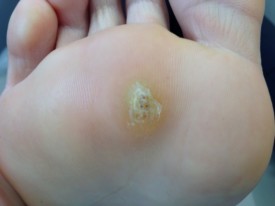
Plantar warts and all other warts are caused by the HPV virus.
There are over 100 types of human warts and all of them are caused by the contraction of various strains of HPV virus. Bacteria, fungus, and parasites do not cause warts, although they can cause other serious bodily infections. And contrary to the fairy tale, touching frogs or toads does not put one at risk for contracting warts.
What type of virus causes warts?
The human papillomavirus, or HPV, is the sole source of every type of wart found on the human body. Whether you have warts on the foot (plantar warts), tiny warts on your hands or fingers, genital warts, or filiform warts (facial warts), they all originated from the contraction of a virus.
The HPV virus that causes warts is actually a milder strain of the same virus that causes herpes. I know this sounds creepy, but before you get too alarmed, understand that the HPV virus is ubiquitous. Almost every person will have at least one wart in their lifetime because the wart viruses are everywhere and easy to contract.
How does the HPV virus become a wart?
The birth of a wart occurs when the HPV virus becomes embedded in the outer layer of the skin. The epidermis, or outer layer of skin, is a protective shield for the body against all types of potential foreign invaders: bacteria, fungi, and viruses. Cuts and abrasions on the skin, regardless of how minute they may be, allow an entryway to the body for these microscopic intruders.
HPV viruses spread only through direct contact with another infected individual or contact with an inanimate object that has been contaminated by infected person. It is no coincidence that the hands are the most common location on the body for warts, because we are constantly touching objects in our environment with our hands. You can contract the wart virus from many seemingly innocuous activities, such as shaking hands with or using the face towel of an infected person.
When a wart begins to grow, it causes an unnatural growth of benign cells to occur on the surface of the skin. Most warts form a hardened covering around their circumference as a sort of shield. However, not all warts have this protective shell. For example, filiform warts are soft and fleshy like skin tags, and look like branches or twigs growing on the skin.
How to kill wart viruses?
The human immune system detects the HPV virus and attempts to fight and kill it before it can become a wart. The virus can lay dormant for months, however, waiting for weakness in the immune system before progressing. So the wart that is growing on your body now may have been contracted from a virus a long time ago. When the immune system is weak, viruses, fungi, bacteria, and parasites all have a greater chance of infecting the body.
Younger people are more susceptible to getting warts because their immune system has not developed resistance to the many types of HPV virus like older people have. As the body is exposed to and fights the different strains, it naturally develops immunity to them. Even after killing the wart, the HPV virus never totally disappears from the body. The body can develop an immunity to it, effectively preventing future infections, but testing can reveal the presence of the virus, nonetheless.
Even already developed warts are still being fought by the body’s defense systems. Over time, most warts will simply disappear on their own even if left untreated. This is because skin cells, including wart cells, shed naturally over time. As the skin sheds and regenerates itself, warts can disappear and go away on their own. This is not true of all warts, however. Stubborn wart removal will require a visit to your friendly dermatologist, or the use of an effective over-the-counter wart removal product.
How to prevent warts
You can prevent contraction of the HPV virus by properly covering any cuts or scrapes that you have on your skin. Parts of the body that are regularly shaved, like men’s faces or women’s legs, are prone to getting infected with HPV through nicks and cuts made while shaving. Don’t share towels, razors, or the like because this will leave you open to infection. To prevent genital warts, be sure follow safe sex practices.
Additionally, remove small warts before they have a chance to get deeply rooted in the skin, when they will be much more difficult to get rid of. Small warts are easily removed with an over-the-counter wart remover cream a patch that uses the ingredient salicylic acid. On undeveloped warts, these products will be successful about three fourths of the time. If that doesn’t work, then make a visit to local dermatologist for wart removal.
OTC Medicine for Wart Removal
 |  |  |  |
| Wart Remover Pads/Adhesives | Liquid Wart Remover | Wart Freeze Off | Wart Removal Pen |


Leave a Reply